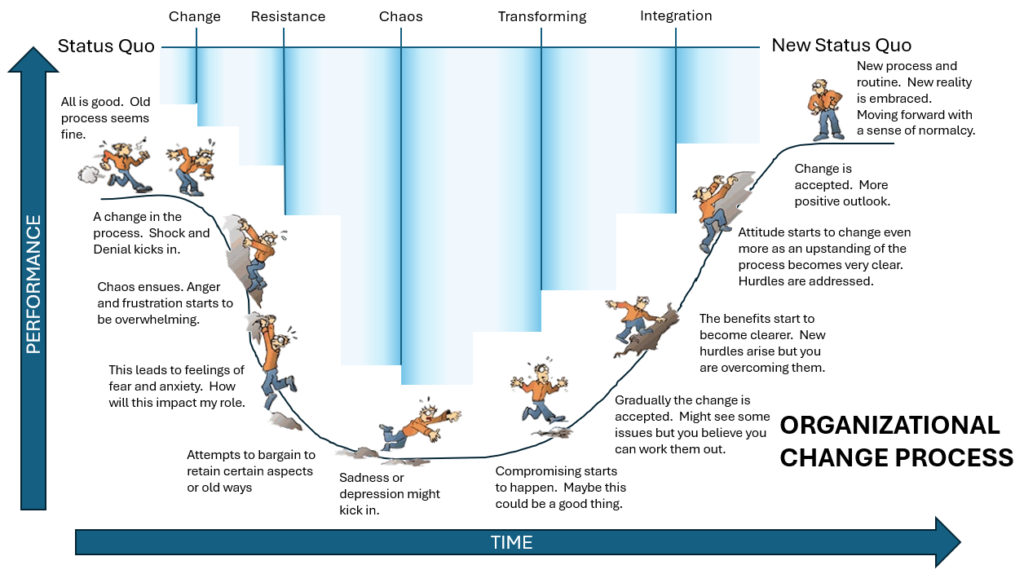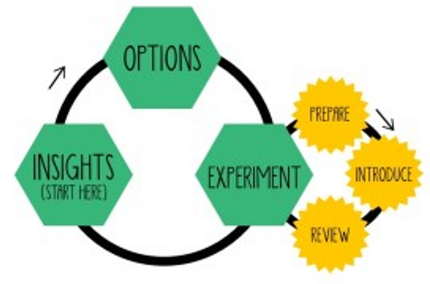“If you change nothing, nothing will change.” Nailed it. This nugget of wisdom is a reminder that stagnation breeds more of the same. Progress requires action, and action brings about transformation. So, what’s one small change you think could make a big difference in your organization right now? This article will discuss Change Management as it relates to any size organization.

What is Change Management
Change management is the structured approach organizations use to transition from their current state to a desired future state. It involves planning, implementing, and monitoring changes to processes, systems, structures, or behaviors within the organization. The goal is to ensure that changes are smoothly and successfully implemented, and that they deliver the intended benefits.
Key Elements of Change Management
- Communication: Clearly explain the need for change, the benefits, and how it will be implemented. Transparent communication helps alleviate fears and resistance.
- Leadership Support: Strong and visible support from leaders is crucial to drive change and inspire confidence among employees.
- Employee Involvement: Engaging employees in the change process increases buy-in and reduces resistance. This can be through feedback sessions, workshops, or pilot programs.
- Training and Support: Providing adequate training and resources helps employees adapt to new ways of working and ensures they have the skills needed for the change.
- Monitoring and Feedback: Regularly assessing the progress of the change implementation and gathering feedback allows for adjustments and improvements.
- Celebrating Successes: Recognizing and celebrating milestones and achievements during the change process helps maintain momentum and morale.
Stages of Change Management
- Preparation: Assess the current state and identify the need for change. Develop a change management plan and communicate the vision.
- Implementation: Execute the change plan, providing training and resources to support employees. Maintain open communication and address any issues that arise.
- Sustainment: Ensure the change is integrated into the organization’s culture and operations. Monitor progress and make necessary adjustments to solidify the change.
Effective change management helps organizations adapt to evolving market conditions, improve efficiency, and remain competitive.
Change Management Models
Below are three popular change models that can be used to guide and change within an organization. One model has its merits. If your organization chooses to use a particular change model, stick with that one for all changes so that the organization will be consistent in its change method.
1. Lewin’s Change Management Model. Developed by Kurt Lewin, this model is based on three stages:
- Unfreeze: Preparing the organization for change by breaking down the existing status quo. This involves overcoming resistance and creating a sense of urgency.
- Change: Implementing the change. This is the transition phase where the organization moves towards the desired state.
- Refreeze: Solidifying the change by embedding new behaviors into the organizational culture. This ensures that the changes are sustained over time.
2. Kotter’s 8-Step Change Model. John Kotter’s model is more detailed, outlining eight steps to successfully manage change:
- Create Urgency: Inspire people to want the change by highlighting the need for it.
- Form a Powerful Coalition: Assemble a group with enough power to lead the change.
- Create a Vision for Change: Develop a clear vision to help direct the change effort.
- Communicate the Vision: Use every possible channel to communicate the new vision and strategies.
- Remove Obstacles: Get rid of barriers to change, and empower people to execute the vision.
- Create Short-Term Wins: Plan for visible improvements, or “wins,” that can be achieved quickly.
- Build on the Change: Consolidate gains and produce more change, ensuring that early wins are used as a foundation for larger change.
- Anchor the Changes: Reinforce the changes by highlighting the connections between new behaviors and organizational success.
3. ADKAR Model. The ADKAR model, developed by Prosci, focuses on individual change and stands for:
- Awareness: Creating awareness of the need for change.
- Desire: Generating a desire to participate and support the change.
- Knowledge: Providing knowledge about how to change.
- Ability: Ensuring individuals have the ability to implement the change.
- Reinforcement: Reinforcing the change to sustain it.
Key Challenges in Change Management
- Resistance to Change: Change can be unsettling, and employees might resist it due to fear of the unknown, comfort with the status quo, or lack of understanding about the benefits. Strategies to manage resistance include clear communication, involving employees in the change process, and addressing concerns empathetically.
- Managing Communication: Effective communication is crucial but can be challenging. It’s important to maintain transparency, provide regular updates, and ensure that messages are consistent across all channels.
- Aligning Resources: Change often requires reallocation of resources, which can lead to tension and competition. Aligning resources with the change objectives and ensuring that teams are adequately supported is vital.
- Sustaining Momentum: Keeping the momentum going throughout the change process can be difficult. Celebrating small wins and maintaining focus on the long-term vision helps sustain energy and commitment.
- Measuring Success: Defining and measuring success can be complex. It’s important to set clear, achievable goals and use appropriate metrics to track progress and make adjustments as needed.
Best Practices for Effective Change Management
- Involve All Levels: Engage employees at all levels in the change process. Their insights and buy-in are crucial for successful implementation.
- Be Flexible: Change can be unpredictable. Be prepared to adapt strategies and plans as needed to respond to emerging challenges and opportunities.
- Continuous Learning: Encourage a culture of continuous learning and improvement. Provide training and development opportunities to help employees adapt to new ways of working.
- Foster a Supportive Culture: A supportive organizational culture that values innovation and agility can facilitate smoother transitions during change.
- Evaluate and Adjust: Continuously evaluate the impact of the change and be willing to make adjustments. Feedback loops and regular assessments help ensure that the change remains effective and relevant.
Change management is a multifaceted process that requires careful planning, strong leadership, and a collaborative approach. When done well, it can lead to significant improvements in organizational performance and employee satisfaction.
Change Management Phases
Change in an organization typically unfolds through a series of phases. Here’s a deep dive into those stages:
Preparation Phase.
- Awareness and Assessment: Identify the need for change. Understand the driving forces behind the change, whether it’s technological advancements, market shifts, or internal inefficiencies.
- Vision and Strategy: Develop a clear vision for the desired future state and outline the strategy to achieve it. This includes setting goals and identifying key stakeholders.
Planning Phase.
- Stakeholder Engagement: Communicate the vision and strategy to stakeholders. Engage them early to gain their support and address any concerns.
- Change Management Plan: Create a detailed plan outlining the steps needed to implement the change. This should include timelines, resources, and roles and responsibilities.
Implementation Phase.
- Communication and Training: Continuously communicate with employees about the change. Provide training and support to help them adapt to new processes and systems.
- Pilot Programs: Test the change on a small scale, if possible, to identify potential issues and make necessary adjustments before a full-scale rollout.
Transition Phase.
- Execution: Implement the change across the organization. Monitor progress and address any challenges that arise.
- Support Systems: Provide ongoing support to employees, such as help desks or change champions who can assist with the transition.
Consolidation Phase.
- Feedback and Adjustment: Collect feedback from employees and stakeholders. Make any necessary adjustments to ensure the change is effective and sustainable.
- Celebrating Success: Recognize and celebrate milestones and successes to maintain momentum and morale.
Sustainability Phase.
- Integration: Embed the change into the organizational culture. Ensure that new behaviors and processes become the standard way of operating.
- Continuous Improvement: Regularly review and refine the change. Encourage a culture of continuous improvement to keep the organization agile and responsive.
These phases provide a structured approach to managing change, helping organizations navigate the complexities and achieve their desired outcomes effectively.
Emotional Stages During Organizational Change
Navigating through organizational change can be quite an emotional rollercoaster. Here are the common stages:
- Shock and Denial: Initially, people might be surprised or in denial about the change. This stage is characterized by confusion and disbelief as individuals struggle to accept the reality of the new situation.
- Anger and Frustration: Once the initial shock wears off, emotions such as anger, frustration, or resentment can surface. This is a natural reaction to the perceived loss of the status quo and control.
- Fear and Anxiety: Concerns about the future can lead to feelings of fear and anxiety. People might worry about how the change will impact their roles, responsibilities, and job security.
- Bargaining: During this stage, individuals may attempt to negotiate or bargain to retain certain aspects of the old way of doing things. They might try to find compromises that make the change more palatable.
- Depression and Low Energy: A sense of sadness or low energy can set in as the reality of the change becomes clearer. Motivation may dip, and people might feel a sense of loss or hopelessness.
- Acceptance: Gradually, individuals begin to accept the change. They start to see the benefits and adjust their mindset. This stage is marked by a more positive and proactive attitude.
Integration: In the final stage, people fully integrate the change into their daily routines and behaviors. They embrace the new reality and move forward with a sense of normalcy and optimism.

Everyone experiences these stages differently and at their own pace. Recognizing these emotional phases can help organizations provide better support and facilitate a smoother transition.
Move from Old Status Quo to a New Status Quo
Making the leap from an old status quo to a new one requires strategic planning and execution. Here’s a blueprint to guide that transformation:
- Recognize the Need for Change: Understand the drivers behind the need for change, whether it’s market dynamics, internal inefficiencies, or technological advancements. Clearly articulate why the change is necessary to build a compelling case.
- Define the Vision: Outline a clear vision of the desired future state. This vision should be inspiring and align with the company’s core values and goals. It acts as a guiding star for all change-related activities.
- Engage Stakeholders: Involve key stakeholders from the beginning. Their support and buy-in are crucial for smooth implementation. This includes top management, middle managers, and employees who will be directly affected by the change.
- Develop a Change Management Plan: Create a detailed plan that outlines the steps needed to transition from the old status quo to the new one. This should include timelines, resources, roles, and responsibilities.
- Communicate Effectively: Transparent and continuous communication is key. Keep everyone informed about the vision, the reasons for the change, the benefits, and the progress. Address any concerns and provide regular updates.
- Empower and Train Employees: Equip employees with the necessary skills and knowledge to adapt to the new status quo. Offer training programs, workshops, and support resources to help them navigate the transition.
- Implement in Phases: Break down the change into manageable phases. Pilot programs can be particularly useful to test new processes or systems before a full-scale rollout. This allows for adjustments and fine-tuning.
- Monitor and Adjust: Continuously monitor the progress of the change initiative. Gather feedback, track key metrics, and be prepared to make adjustments as needed. Flexibility is essential for addressing unforeseen challenges.
- Celebrate Milestones: Recognize and celebrate achievements along the way. This helps maintain momentum and morale. Celebrations can be big or small but should acknowledge the efforts and successes of everyone involved.
- Embed the Change: Ensure that the new status quo becomes the standard way of operating. Embed new behaviors and practices into the organizational culture. Regularly reinforce the change through communication, training, and leadership support.
- Sustain and Evolve: Continue to evaluate and refine the new status quo. Encourage a culture of continuous improvement to keep the organization agile and responsive to future changes.
Transitioning to a new status quo is a journey that requires patience, persistence, and a collective effort. When done thoughtfully, it can lead to significant improvements and set the stage for long-term success. Have you experienced any major transitions in your organization?
Managed Change vs. Unmanaged Change
Managed change and unmanaged change are two distinct approaches to implementing change within an organization, each with its own set of implications and outcomes.
Managed Change:
- Planned and Structured: Managed change is carefully planned and follows a structured process. It involves a clear strategy, objectives, and a timeline.
- Stakeholder Engagement: Key stakeholders are involved and their input is considered. This includes leadership, employees, and other relevant parties.
- Communication: There is transparent and continuous communication throughout the change process. This helps to ensure everyone is informed and aligned with the change.
- Support and Training: Employees receive adequate support and training to adapt to the change. Resources are provided to help them navigate the transition.
- Monitoring and Adjustment: Progress is regularly monitored and feedback is gathered. Adjustments are made as necessary to address any issues or challenges.
- Risk Management: Potential risks are identified and mitigated proactively, reducing the likelihood of negative impacts.
Unmanaged Change:
- Unplanned and Ad Hoc: Unmanaged change lacks planning and structure. It is often reactive rather than proactive, with changes being made on-the-fly.
- Lack of Stakeholder Involvement: Key stakeholders may not be consulted or involved, leading to resistance and a lack of buy-in.
- Poor Communication: Communication is often sporadic or unclear, resulting in confusion and uncertainty among employees.
- Inadequate Support: Employees may not receive the necessary support or training to adapt to the change, leading to frustration and decreased productivity.
- Limited Monitoring: Progress is not regularly monitored, and feedback is not systematically gathered. This makes it difficult to identify and address issues promptly.
- Higher Risk: Without proper risk management, unmanaged change can lead to unforeseen problems and negative consequences.
In essence, managed change is a proactive and organized approach that maximizes the chances of success, while unmanaged change is a reactive and chaotic approach that can lead to significant challenges and disruptions.

Complex Organizational Change
Handling complex change in an organization is like conducting a symphony—each section must be in harmony for the whole piece to come together beautifully. Here’s a guide to navigating this intricate process:
1. Establish a Strong Foundation:
- Vision and Strategy: Begin with a clear, compelling vision and a well-thought-out strategy. This provides direction and helps align all efforts towards a common goal.
- Leadership Commitment: Ensure that leadership is fully committed and actively involved. Their support is crucial for driving the change and inspiring confidence throughout the organization.
2. Detailed Planning:
- Change Management Framework: Utilize a robust change management framework tailored to the organization’s specific needs. This should outline the steps, timelines, and resources required.
- Risk Assessment: Identify potential risks and develop contingency plans. This proactive approach can mitigate obstacles before they become major issues.
3. Engage and Communicate:
- Stakeholder Engagement: Involve key stakeholders early and often. Their input and support can significantly impact the success of the change initiative.
- Transparent Communication: Maintain open and honest communication. Keep everyone informed about the vision, the process, and their roles. Address concerns and provide regular updates to build trust.
4. Empower and Equip Employees:
- Training and Development: Offer comprehensive training programs to equip employees with the necessary skills and knowledge. Continuous support helps ease the transition and boosts confidence.
- Change Champions: Identify and empower change champions within the organization. These individuals can advocate for the change, provide support to their peers, and help maintain momentum.
5. Implement Gradually:
- Phased Approach: Break down the change into manageable phases. Implementing changes gradually allows for adjustments and minimizes disruption.
- Pilot Programs: Start with pilot programs to test new processes or systems. Use the feedback to refine and improve before a full-scale rollout.
6. Monitor and Adapt:
- Progress Tracking: Regularly monitor the progress of the change initiative. Use metrics and feedback to assess what’s working and what needs adjustment.
- Flexibility: Be prepared to adapt strategies as needed. Flexibility is crucial in navigating the complexities of change.
7. Support and Sustain:
- Ongoing Support: Provide continuous support through help desks, FAQs, and regular check-ins. Ensure employees have access to the resources they need.
- Reinforce New Behaviors: Embed new behaviors and practices into the organizational culture. Use recognition and reward systems to reinforce the desired changes.
8. Celebrate Milestones:
- Recognize Achievements: Celebrate successes and milestones to maintain morale and motivation. Recognition can be a powerful tool in reinforcing the change.
9. Continuous Improvement:
- Feedback Loops: Establish feedback mechanisms to gather input from employees and stakeholders. Use this feedback to make continuous improvements.
- Learning Culture: Foster a culture of continuous learning and improvement. Encourage innovation and adaptability to keep the organization agile and responsive.
Managing complex change requires meticulous planning, strong leadership, and a collaborative approach. It’s about guiding the organization through the transition with clarity, support, and a focus on long-term success.
Below diagram shows the outcome of complex change when you have the key ingredients and when one of those ingredients is missing.

Lean Change Management Cycle
The Lean Change Management Cycle is a structured yet flexible approach to managing change in organizations. It consists of four main stages: Insights, Options, Experiments, and Review. The cycle is iterative, meaning it’s designed to continuously cycle through these stages for ongoing improvement
Stages of the Lean Change Management Cycle:
Insights:
- Gather Information: Collect insights about the organization, its people, and the desired changes. This often involves understanding pain points and areas that need improvement
- Create Change Canvases: Use tools like change canvases to visualize and communicate the change initiative
Options:
- Brainstorm Solutions: Generate a range of potential solutions or options to address the identified issues
- Evaluate Options: Assess the feasibility and impact of each option to determine the best course of action.
Experiments:
- Pilot Programs: Implement the chosen solutions on a small scale through pilot programs
- Test and Learn: Test the solutions in real-world scenarios, gather feedback, and learn from the outcomes.
Review:
- Analyze Results: Review the results of the experiments to determine their effectiveness
- Adjust and Iterate: Based on the feedback and results, make necessary adjustments and iterate through the cycle again
The experiments section has three sub-phases that are made up of Prepare, Introduce and Review.
The Lean Change Management Cycle emphasizes continuous improvement and adaptability, making it well-suited for today’s fast-paced and ever-evolving business landscape
It’s about being responsive and making incremental changes that lead to significant improvements over time.

Change Management Summary
Organizational change management is the structured approach to transitioning individuals, teams, and organizations from a current state to a desired future state. It involves planning, implementing, and monitoring changes to processes, systems, or behaviors to ensure smooth and successful outcomes.
Key Elements:
- Vision and Strategy: Develop a clear vision and strategy for the change.
- Stakeholder Engagement: Involve and engage stakeholders early and continuously.
- Communication: Maintain open and transparent communication.
- Training and Support: Provide necessary training and support for employees.
- Pilot Programs: Implement changes on a small scale first, if possible.
- Monitoring and Adaptation: Regularly monitor progress and make necessary adjustments.
- Celebration of Successes: Recognize and celebrate milestones to maintain momentum.
Phases:
- Preparation: Assess the need for change and develop a plan.
- Planning: Outline the steps and resources required for implementation.
- Implementation: Execute the plan and support employees through the transition.
- Consolidation: Reinforce the change and embed it into the organizational culture.
- Sustainability: Continuously evaluate and refine the change to ensure long-term success.
Effective change management leads to improved organizational performance, higher employee satisfaction, and long-term success. It’s a journey that requires careful planning, strong leadership, and ongoing commitment.




